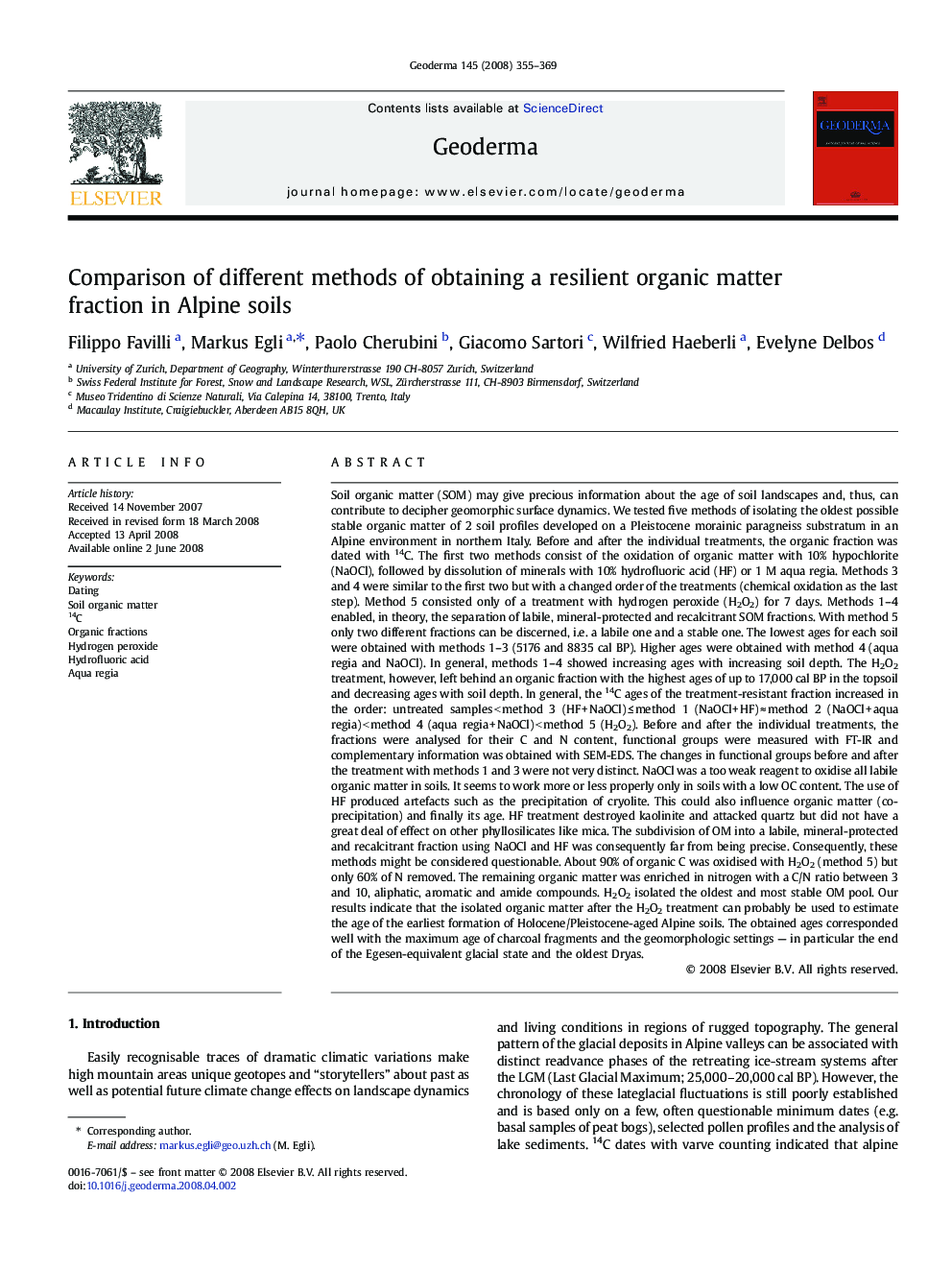| کد مقاله | کد نشریه | سال انتشار | مقاله انگلیسی | نسخه تمام متن |
|---|---|---|---|---|
| 4574959 | 1629542 | 2008 | 15 صفحه PDF | دانلود رایگان |

Soil organic matter (SOM) may give precious information about the age of soil landscapes and, thus, can contribute to decipher geomorphic surface dynamics. We tested five methods of isolating the oldest possible stable organic matter of 2 soil profiles developed on a Pleistocene morainic paragneiss substratum in an Alpine environment in northern Italy. Before and after the individual treatments, the organic fraction was dated with 14C. The first two methods consist of the oxidation of organic matter with 10% hypochlorite (NaOCl), followed by dissolution of minerals with 10% hydrofluoric acid (HF) or 1 M aqua regia. Methods 3 and 4 were similar to the first two but with a changed order of the treatments (chemical oxidation as the last step). Method 5 consisted only of a treatment with hydrogen peroxide (H2O2) for 7 days. Methods 1–4 enabled, in theory, the separation of labile, mineral-protected and recalcitrant SOM fractions. With method 5 only two different fractions can be discerned, i.e. a labile one and a stable one. The lowest ages for each soil were obtained with methods 1–3 (5176 and 8835 cal BP). Higher ages were obtained with method 4 (aqua regia and NaOCl). In general, methods 1–4 showed increasing ages with increasing soil depth. The H2O2 treatment, however, left behind an organic fraction with the highest ages of up to 17,000 cal BP in the topsoil and decreasing ages with soil depth. In general, the 14C ages of the treatment-resistant fraction increased in the order: untreated samples < method 3 (HF + NaOCl) ≤ method 1 (NaOCl + HF) ≈ method 2 (NaOCl + aqua regia) < method 4 (aqua regia + NaOCl) < method 5 (H2O2). Before and after the individual treatments, the fractions were analysed for their C and N content, functional groups were measured with FT-IR and complementary information was obtained with SEM-EDS. The changes in functional groups before and after the treatment with methods 1 and 3 were not very distinct. NaOCl was a too weak reagent to oxidise all labile organic matter in soils. It seems to work more or less properly only in soils with a low OC content. The use of HF produced artefacts such as the precipitation of cryolite. This could also influence organic matter (co-precipitation) and finally its age. HF treatment destroyed kaolinite and attacked quartz but did not have a great deal of effect on other phyllosilicates like mica. The subdivision of OM into a labile, mineral-protected and recalcitrant fraction using NaOCl and HF was consequently far from being precise. Consequently, these methods might be considered questionable. About 90% of organic C was oxidised with H2O2 (method 5) but only 60% of N removed. The remaining organic matter was enriched in nitrogen with a C/N ratio between 3 and 10, aliphatic, aromatic and amide compounds. H2O2 isolated the oldest and most stable OM pool. Our results indicate that the isolated organic matter after the H2O2 treatment can probably be used to estimate the age of the earliest formation of Holocene/Pleistocene-aged Alpine soils. The obtained ages corresponded well with the maximum age of charcoal fragments and the geomorphologic settings — in particular the end of the Egesen-equivalent glacial state and the oldest Dryas.
Journal: Geoderma - Volume 145, Issues 3–4, 15 June 2008, Pages 355–369